Search myodfw.com
At certain estuaries and interior alkali lakes, flocks of many thousands of these migrants can be observed swirling around over shallow water, landing to frantically feed, before resuming migration. Falcons often attack Westerns, and their acrobatic, tightly coordinated escape flights are breathtaking to observe. In winter, these small sandpipers are gray above with white underparts. In breeding plumage they have a rich rufous-chestnut back, cheeks and cap, dark-centered scapulars with rufous-chestnut edges, grayish throats streaked with dark chevrons through the flank, and whitish underparts. Longer-billed females generally are larger than males but are otherwise similar in appearance. Along the coast

This is the world's smallest "peep" and can usually be picked out by its brownish coloration, dull yellowish legs, and hunched, creeping foraging style. Least can be found in small flocks in Oregon almost year-round. The Least sandpiper feeds on open mud with Western sandpipers but often feeds where some grass, salicornia or other cover is present, avoiding walking in the water as Western often do. It is uncommon to locally abundant statewide in migration, with most birds along the coast and at larger lakes and marshes inland. It is locally common on the coast in winter; smaller numbers winter

These large "peeps" are seen in Oregon mainly in late summer and fall, when their size, scalloped buffy plumage, and long profile help them stand out in flocks of other small sandpipers. It is an uncommon migrant statewide, with most birds southbound juveniles. It can occur in suitable habitat anywhere in Oregon, but numbers are usually very low and sizable flocks almost nonexistent. Hear the call of the Baird's sandpiper Photo by Howard Patterson, Flickr

These brownish, heavily streaked, medium-sized shorebirds are often seen peering over grass in the more overgrown parts of mudflats, especially in fall. It is found statewide in migration; largest numbers in fall, and it is sometimes all but absent in spring. It is common on the outer coast but also in wet coastal pastures. They are more local inland but large flocks can be found in preferred habitat. Hear the call of the Pectoral sandpiper Photo by Jason Crotty, Flickr

This is a portly, brightly colored shorebird, typically found in coastal salt marshes, mud flats, and sandy margins of freshwater ponds. Migrant juveniles rather than adults appear in Oregon. They have a flattish, dark rufous-colored crown with fine black streaking. The crown gives the appearance of a jaunty "cap" sitting forward on the head and abruptly ending at the rear. The breast is rich orange-buff shading into the white lower breast and belly. The well-defined creamy-white supercilium broadens behind the eye and is visible at a considerable distance. This is one of the most distinctive field marks on juveniles. They
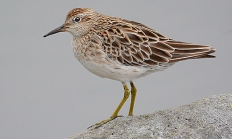
This medium sized, stocky sandpiper is rarely observed away from the rocky coastline as it forages close to the zone of salt spray. Primarily a late fall migrant with the major influx into Oregon occurring the last week in October and into early November. Generally silent during migration and on wintering grounds. Often found singly or in small groups with foraging Black turnstones and Surfbirds. Cryptic plumage makes it difficult to observe as it forages slowly over mussel and barnacle beds in typical sandpiper fashion. Roosts on rocks with Black turnstones and Surfbirds near feeding grounds, just above the spray

The Dunlin undergoes one of the most dramatic changes in appearance of all shorebirds when it molts from winter to breeding plumage. In winter, these medium sized sandpipers are brownish gray above with white underparts, but in breeding plumage they have a striking rufous-brown back and cap and black belly. Females are larger than males but otherwise similar in appearance. The Dunlin is an abundant transient and winter visitant in estuaries and occasionally on beaches along the coast of Oregon, but significant numbers winter in the Willamette Valley, especially the southern part. Hear the call of the Dunlin Photo by

This slender sandpiper is a rare but nearly annual visitor to Oregon. Although easily overlooked, its drooped bill, light eyeline, long neck, long greenish legs, and unstriped wings in flight help set this medium-sized shorebird apart from similar species. Its preferred habitat during migration is shallow freshwater, usually avoiding mudflats and beaches. It feeds on invertebrates such as midge, beetle and mosquito larvae. A rare fall and occasional spring transient, it is most frequently found in estuarine habitat along the coast. It is also found along the shorelines of the Great Basin region. Hear the call of the Stilt sandpiper
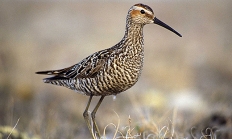
The Buff-breasted sandpiper resembles a plover with a high-stepping, pigeon-like gait. One of the few Oregon shorebirds that frequents dry, sparsely vegetated coastal grasslands. Fall migrants consist of juveniles. It has scaly, buffy-brown underparts, yellow legs, a small head, and a short black bill. Beady black eyes stand out on a plain, pale face. It bobs its head while moving. Gleaming white underwings are displayed in a graceful flight pattern. It is unique among North American shorebirds in having a lek mating system. This is a rare but regular fall migrant on the Oregon coast where it has been recorded
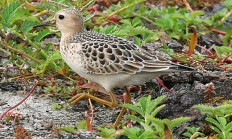
The male Ruff is a relatively large, distinctive, Eurasian shorebird that in breeding plumage sports head tufts and neck plumes from which it gained its name. However, most Ruffs seen in Oregon are juveniles that appear as lanky, buff-colored, pot-bellied, short-billed sandpipers showing white on both sides of the rump in flight. Females are about 20 percent smaller than males and are referred to as reeves. It is usually found on mudflats of coastal estuaries and adjoining wet meadows. The Ruff takes mostly aquatic insects, but will take crustaceans, mollusks, and some worms as well. The Ruff is a rare
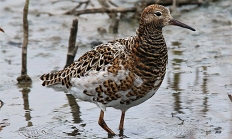
These chunky medium-small shorebirds are quite colorful in oranges and browns during most of their time in Oregon, where they are found mainly along the coast and locally in muddy areas inland. Their feeding motion has been likened to a sewing machine as flocks move slowly through shallow water and wet mud, probing with long straight bills. They are occasionally seen in marginal areas such as flooded pastures, but less likely than Long-billed to use such upland locations. They are a common to locally abundant coastal migrant, less common and more local in western interior valleys, and rare bur regular
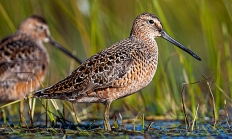
This medium-sized shorebird is the most common dowitcher in eastern Oregon and inland locations, where it sometimes gathers in large flocks feeding in shallow water. It is also the only dowitcher in the state that regularly winters. Although breeding plumage adults are reddish below and heavily patterned above, most birds seen in Oregon are duller postbreeding adults or browner immatures. During winter, when shorebirds are hard to find, a small flock of chattering dowitchers, even in plain gray basic plumage, often brightens a day in western Oregon. In migration, it can be found at almost any shallow water site in

Cryptically colored, usually solitary and somewhat secretive, the Wilson snipe is often flushed before being seen, sometimes exploding from practically underfoot and rocketing off in a corkscrew flight. This plump-bodied, long-billed bird of open marshland is primarily crepuscular, peaking in feeding activity at dusk and dawn, and often sleeping during the day. In breeding season they become more flamboyant, appearing atop fence posts and displaying their unique winnowing flights from high in the air, their outer tail feathers vibrating with an eerie whistling sound. They are uncommon and local west of the Cascades in the summer and uncommon and local

This is the largest and most terrestrial of the three species of phalaropes in Oregon. It is similar in shape to other Phalaropes, but larger size, longer bill and neck, lack of bar on the wing, and white rump distinguish it. In adaptation to a more terrestrial life than other Phalaropes, its toes are fringed, not lobed. It is a common transient and breeder east of the Cascades. The largest numbers breed on the great marshes of southeast Oregon. They are rare visitor west of the Cascades. Hear the call of the Wilson's phalarope Photo by Charlotte Ganskopp
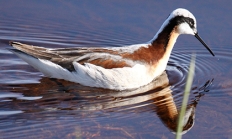
The thick, dense feathering on its underparts allows this dainty shorebird to float high on the water. Its lobbed toes give it considerable maneuverability while swimming. It is equally at home on the roughest seas and the smallest farm pond. A highly sociable bird and extremely trusting. Smaller size and slender bill separate this species from the Wilson's and Red phalaropes. Offshore it concentrates along tide rips and over upwellings. In shallow waters it stirs the bottom with its feet or spins rapidly to expose the tiny organisms that it picks up with its needlelike bill. An opportunistic forager of

Flying over the water in small flocks or riding the ocean swells like puffs of down, a more incongruous picture can hardly be imagined than these dainty mites riding the waves during rough weather, apparently entirely indifferent to the tumult of waters. Pelagic shorebirds, they come to shore only to breed. Adapted to life on the sea, they have glands that allow them to expel salt from the seawater they drink, and lobed, coot-like toes to swim. Brick red in their breeding plumage, they are mostly gray and white in winter. They are uncommon to common spring and fall transients
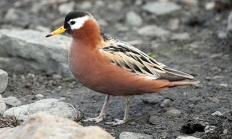
Gulls and terns can be seen year-round in Oregon, depending on the species. Gulls like open areas around water bodies and are frequently seen where human food is concentrated, such as dumps or restaurants. Terns are in the same family and usually are smaller and more slender.

Graceful and tern-like in many of its actions, this striking little gull displays flashing white outer primaries that contrast with a gray back. The Bonaparte's gull is an abundant spring and fall transient along the coast, primarily over the ocean just offshore and is fairly common and widespread elsewhere in Oregon, usually in flocks of less than 100. Larger flocks of up to 1,000 have occurred at Fern Ridge Reservoir in Lane County, during extreme storm conditions, and in the Klamath Basin. Hear the call of the Bonaparte's gull Photo by Martyne Reesman, ODFW

Heermann's gulls, the warm-water gulls of summer and fall, accompany Brown pelicans as they fly north each summer. Although most feed along the shore or in the ocean, some feed on tide flats. They often steal food from Brown pelicans. They may take fish directly from the pelicans' bills immediately after a dive or claim food that pelicans have located, discarded, or disturbed. This gull is common on the outer seacoasts, beaches, bays and estuaries. They are strongly associated with outer coasts and adjacent ocean waters, usually within a few miles of shore. A few wander inland during the fall

This small, gentle looking gull is one of the most abundant wintering gulls along the Pacific coast. It is often found foraging in mixed flocks with Ring-billed, and to a lesser extent, California gulls. Its small plover-like head and bill, and the habit of bobbing its head while walking, make it fairly easy to identify. It is most often found actively foraging with similar-sized gulls on coastal farm fields and short grass meadows and lawn when such habitat is moist. This is an abundant migrant and winter visitor along the coast, the lower Columbia River and in the Willamette Valley

